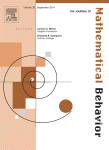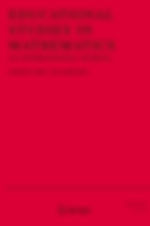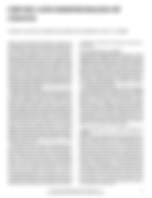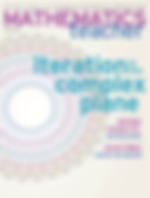Publications

Clark, P. G., Moore, K. C., & Carlson, M. P. (2008). Documenting the emergence of "speaking with meaning" as a sociomathematical norm in professional learning community discourse. The Journal of Mathematical Behavior, 27(24), 297-310.
We introduce the sociomathematical norm of speaking with meaning and describe its emergence in a professional learning community (PLC) of secondary mathematics and science teachers. We use speaking with meaning to reference specific attributes of individual communication that have been revealed to improve the quality of discourse among individuals engaged in discourse in a PLC. An individual who is speaking with meaning provides conceptually based descriptions when communicating with others about solution approaches. The quantities and relationships between quantities in the problem context are described rather than only stating procedures or numerical calculations used to obtain an answer to a problem. Solution approaches are justified with logical and coherent arguments that have a conceptual rather than procedural basis. The data for this research was collected during a year-long study that investigated a PLC whose members were secondary mathematics and science teachers. Analysis of the data revealed that after one semester of participating in a PLC where speaking with meaning was emphasized, the PLC members began to establish their own criteria for an acceptable mathematical argument and what constituted speaking with meaning. The group also emerged with common expectations that answers be accompanied by explanations and mathematical operations be explained conceptually (not just procedurally). The course and PLC design that supported the emergence of speaking with meaning by individuals participating in a PLC are described.

Moore, K. C., & Carlson, M. P. (2012). Students’ images of problem contexts when solving applied problems. The Journal of Mathematical Behavior, 31(1), 48-59.
This article reports findings from an investigation of precalculus students’ approaches to solving novel problems. We characterize the images that students constructed during their solution attempts and describe the degree to which they were successful in imagining how the quantities in a problem’s context change together. Our analyses revealed that students who mentally constructed a robust structure of the related quantities were able to produce meaningful and correct solutions. In contrast, students who provided incorrect solutions consistently constructed an image of the problem’s context that was misaligned with the intent of the problem. We also observed that students who caught errors in their solutions did so by refining their image of how the quantities in a problem’s context are related. These findings suggest that it is critical that students first engage in mental activity to visualize a situation and construct relevant quantitative relationships prior to determining formulas or graphs.

Moore, K. C. (2012). Coherence, quantitative reasoning, and the trigonometry of students. In R. Mayes & L. L. Hatfield (Eds.), Quantitative reasoning and mathematical modeling: A Driver for STEM integrated education and teaching in context (pp. 75-92). Laramie, WY: University of Wyoming.
Over the past five years I have sought to better understand student thinking and learning in the context of topics central to trigonometry, including angle measure, the unit circle, trigonometric functions, periodicity, and the polar coordinate system. While each study has provided unique insights into students’ learning of trigonometry, a common theme connects the studies’ findings: quantitative reasoning plays a central role in students’ trigonometric understandings. In this chapter, I first describe a coherent system of understandings for trigonometry that is grounded in quantitative reasoning. Against this backdrop, I compare students’ quantitative reasoning in the context of trigonometry in order to illustrate the role of quantitative reasoning in the learning of a particular mathematical topic.

Moore, K. C. (2013). Making sense by measuring arcs: A teaching experiment in angle measure. Educational Studies in Mathematics, 83(2), 225-245.
I discuss a teaching experiment that sought to characterize precalculus students’ angle measure understandings. The study’s findings indicate that the students initially conceived angle measures in terms of geometric objects. As the study progressed, the students formed more robust understandings of degree and radian measures by constructing an arc length image of angle measures; the students’ quantification of angle measure entailed measuring arcs and conceiving multiplicative relationships between a subtended arc, a circle’s circumference, and a circle’s radius. The students leveraged these quantitative relationships to transition between units with a fixed magnitude (e.g., an arc length’s measure in feet) and various angle measure units, while maintaining invariant meanings for angle measures in different units. These results suggest that quantifying angle measure, regardless of unit, through processes that involve measuring arc lengths can support coherent angle measure understandings.

Moore, K. C., Paoletti, T., & Musgrave, S. (2013). Covariational reasoning and invariance among coordinate systems. The Journal of Mathematical Behavior, 32(3), 461-473.
Researchers continue to emphasize the importance of covariational reasoning in the con- text of students’ function concept, particularly when graphing in the Cartesian coordinate system (CCS). In this article, we extend the body of literature on function by characterizing two pre-service teachers’ thinking during a teaching experiment focused on graphing in the polar coordinate system (PCS). We illustrate how the participants engaged in covaria- tional reasoning to make sense of graphing in the PCS and make connections with graphing in the CCS. By foregrounding covariational relationships, the students came to understand graphs in different coordinate systems as representative of the same relationship despite differences in the perceptual shapes of these graphs. In synthesizing the students’ activ- ity, we provide remarks on instructional approaches to graphing and how the PCS forms a potential context for promoting covariational reasoning.

Castillo-Garsow, C., Johnson, H. L., & Moore, K. C. (2013). Chunky and smooth images of change. For the Learning of Mathematics, 33(3), 31-37.
Characterizing how quantities change (or vary) in tandem has been an important historical focus in mathematics that extends into the current teaching of mathematics. Thus, how students conceptualize quantities that change in tandem becomes critical to their mathematical development. In this paper, we propose two images of change: chunky and smooth. Chunky images of change are based in imagining change as occurring countable and completed amounts, whereas smooth images of change are based in imagining a continually changing experience. Using empirical examples of student work, we illustrate these images of change and their implications.

Moore, K. C. (2014). Quantitative reasoning and the sine function: The case of Zac. Journal for Research in Mathematics Education, 45(1), 102-138.
A growing body of literature has identified quantitative and covariational reasoning as critical for secondary and undergraduate student learning, particularly for topics that require students to make sense of relationships between quantities. The present study extends this body of literature by characterizing an undergraduate precalculus student’s progress during a teaching experiment exploring angle measure and trigo- nometric functions. I illustrate that connecting angle measure to measuring arcs and conceiving the radius as a unit of measure can engender trigonometric meanings that encompass both unit circle and right triangle trigonometry contexts. The student’s progress during the teaching experiment also indicates that a covariation meaning for the sine function supports using the sine function to represent emergent relationships between quantities in novel situations.

Moore, K. C., Silverman, J., Paoletti, T., & LaForest, K. (2014). Breaking conventions to support quantitative reasoning. Mathematics Teacher Educator, 2(2), 141-157.
Quantitative reasoning is critical to developing understandings of function that are important for sustained success
in mathematics. Unfortunately, preservice teachers often do not receive sufficient quantitative reasoning experiences during their schooling. In this paper, we illustrate consequences of underdeveloped quantitative reasoning abilities against the backdrop of central function concepts. We also illustrate tasks that can perturb preservice teachers’ thinking in ways that produce opportunities for quantitative reasoning. By implementing strategically designed tasks, teacher educators can support preservice teachers—and students in general—in advancing their quantitative reasoning abilities and their understanding of secondary mathematics content.

Moore, K. C., & LaForest, K. R. (2014). The circle approach to trigonometry. Mathematics Teacher, 107(8), 616-623.
A connected introduction of anlge measure and the sine function entails quantitative reasoning.
Moore, K. C. (2014). Signals, symbols, and representational activity. In L. P. Steffe, K. C. Moore, L. L. Hatfield, & S. Belbase (Eds.), Epistemic algebraic students: Emerging models of students' algebraic knowing (pp. 211-235). Laramie, WY: University of Wyoming.
Students’ representational activity remains an area of focus in mathematics education research. From a radical constructivist perspective, this area of research faces an inherent difficulty: a person’s knowledge, and hence what they are representing, is fundamentally unknowable to another individual. A consequence of this is that, as a researcher, we can only develop models of the mental operations that might lead a student to produce our interpretations of her or his actions and representations. In this article I draw on notions put forth by several researchers including von Glasersfeld and Piaget to make sense of students’ representational activity. Namely, I distinguish between representations as signals or as symbols, each stemming from different levels of abstraction. In the former, students’ representational activity and meanings are halted at the level of pseudo-empirical abstractions and are thus constrained to carrying out actions. In the latter, students’ representational activity and meanings involve reflective abstractions and are thus operative in that the representations become pointers to internalized processes that need not be carried out. I illustrate these perspectives, including their implications, by presenting student activity across several contexts.

Steffe, L. P., Moore, K. C., Hatfield, L. L., & Belbase, S. (2014). Epistemic algebraic students: Emerging models of students' algebraic knowing. Laramie, WY: University of Wyoming.
Epistemic Algebraic Students: Emergent Models of Students’ Algebraic Knowing (Papers from an Invitational Conference) is the fourth volume in a monograph series published in support of the activities of participates in the Wyoming Institute for the Study and Development of Mathematics Education (WISDOM^e).
Moore, K. C. (2014). Re-presentations and conceptual structures of what? Constructivist Foundations Special Issue - Forty years of Radical Constructivism in Educational Research, 9(3), 371-373.
Education researchers often explain student activity in terms of general thinking and learning processes, including those identified by Cifarelli and Sevim. In this commentary, I refocus Cifarelli and Sevim's discussion in order to hypothesize the organization of mental actions that comprise and support those learning processes.



Moore, K. C., Paoletti, T., & Musgrave, S. (2014) Complexities in students’ construction of the polar coordinate system. The Journal of Mathematical Behavior, 36, 135-149.
Despite the importance of the polar coordinate system (PCS) to students’ study of mathematics and science, there is a limited body of research that explores students’ ways of thinking about the PCS. Research on students’ construction of the PCS is especially sparse. In this article, we highlight several issues that arose spontaneously during a teaching experiment that explored students’ construction of the PCS. We illustrate how students’ angle measure meanings influenced their construction of the PCS. We also discuss how the students’ ways of thinking about the Cartesian coordinate system (CCS) became problematic as they transitioned to the PCS. Collectively, we highlight that students’ ways of thinking about coordinate systems evolve when students reason within and across multiple coordinate systems.